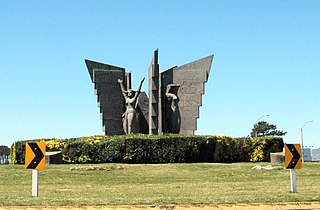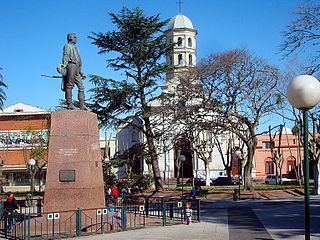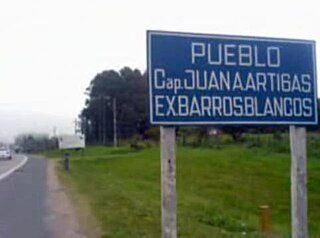
Canelones is the capital of the department of Canelones in Uruguay. Its name is derived from a species of cinnamon, which is called "canelón", growing along the banks of the homonymous river. Since 2010, the city is also the seat of the municipality of Canelones.

Las Piedras is a city in the Canelones Department of Uruguay. As of the census of 2011, it is the seventh most populated city of the country.

Colón Sudeste–Abayubá is a composite barrio of Montevideo, Uruguay.

Ciudad de la Costa is a city in Canelones Department of Uruguay, on the banks of the Río de la Plata between the streams Arroyo Carrasco and Arroyo Pando. It is considered an extension of the metropolitan area of Montevideo which it borders to the west, while to the east it borders Costa de Oro. It was declared a city on 19 October 1994 and given its current name. At the 2011 census, it was the second most populated city of Uruguay between Montevideo and Salto.

Atlántida is a resort town of the Costa de Oro in Canelones Department of Uruguay, 45 kilometres (28 mi) east of Montevideo.

Pando is a city in the Canelones Department of Uruguay. It is an important commercial and industrial centre which has become part of the wider Montevideo metropolitan area.
Toledo is a small city in the Canelones Department of Uruguay. Together with Villa Crespo y San Andrés, it forms a population centre of more than 14,000, which is also generally known as "Toledo", although the censual area of Toledo itself has only about 4,400 inhabitants, according to the 2011 census. They are both part of the wider metropitan area of Montevideo.
Progreso is a city in the Canelones Department of southern Uruguay.

Santa Lucía is a city in the Canelones Department of southern Uruguay.

San Ramón is a small city in the north of Canelones Department, in southern Uruguay.

Aguas Corrientes is a small town in the Canelones Department of southern Uruguay. Its name is derived from the installations of pumping, filtration and purification of water from the Santa Lucia River, which is the largest in the country, supplying drinking water to the departments of Montevideo and Canelones.

Barros Blancos is a city in the Canelones Department of southern Uruguay. In 1976, it had been renamed to Juan Antonio Artigas, after commanding officer Juan Antonio Artigas, grandfather of the national hero José Gervasio Artigas, but the old name was reinstated in 2007.
Migues is a small city in the Canelones Department of southern Uruguay.

Cerrillos or Los Cerrillos is a very small city in the west part of the Canelones Department of southern Uruguay.

Salinas is a city and resort of the Costa de Oro in the Canelones Department of southern Uruguay.
San Bautista is a small city in the Canelones Department of southern Uruguay.

San Jacinto is a small city in the Canelones Department of southern Uruguay, and is also the name of the municipality to which the city belongs.
Sauce is a small city and municipality in the Canelones Department of southern Uruguay.
Paso de Carrasco or Paso Carrasco is a city in the Canelones Department of Uruguay.

Villa Paz S.A. is an urban fragment adjoined to the city of La Paz in the Canelones Department, southern Uruguay.
















